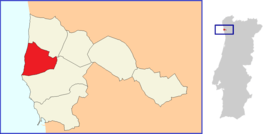Aguçadoura e Navais
União das Freguesias de Aguçadoura e Navais is one of the seven civil parishes of Póvoa de Varzim, Portugal. The administrative parish was created in 2013 from the former parishes Aguçadoura and Navais[1] and it is the reunification of the two parishes which split in 1933. The population in 2011 was 5,745,[2] in an area of 7.40 km².[3] Aguçadoura and Navais are farming parishes north of the city of Póvoa de Varzim and both experienced sharp population decline in the 2011 census.
Aguçadoura e Navais | |
|---|---|
 | |
| Coordinates: 41.43°N 8.77°W | |
| Country | |
| Region | Norte |
| Metropolitan area | Porto |
| District | Porto |
| Municipality | Póvoa de Varzim |
| Area | |
| • Total | 7.40 km2 (2.86 sq mi) |
| Population (2011) | |
| • Total | 5,745 |
| • Density | 780/km2 (2,000/sq mi) |
| Time zone | UTC±00:00 (WET) |
| • Summer (DST) | UTC+01:00 (WEST) |
History
Navais is an ancient ecclesiastical parish with known records dating to the 11th century and the naming is known since the 9th century. Navais was created as a civil parish of Póvoa de Varzim in 1836. The civil parish of Aguçadoura was created in 1933, by splitting Navais. Both parishes were reunified in the new administrative unit in 2013.
References
- Diário da República. "Law nr. 11-A/2013, page 552 101" (pdf) (in Portuguese). Retrieved 29 July 2014.
- Instituto Nacional de Estatística (INE), Census 2011 results according to the 2013 administrative division of Portugal
- "Áreas das freguesias, concelhos, distritos e país". Archived from the original on 2018-11-05. Retrieved 2018-11-05.